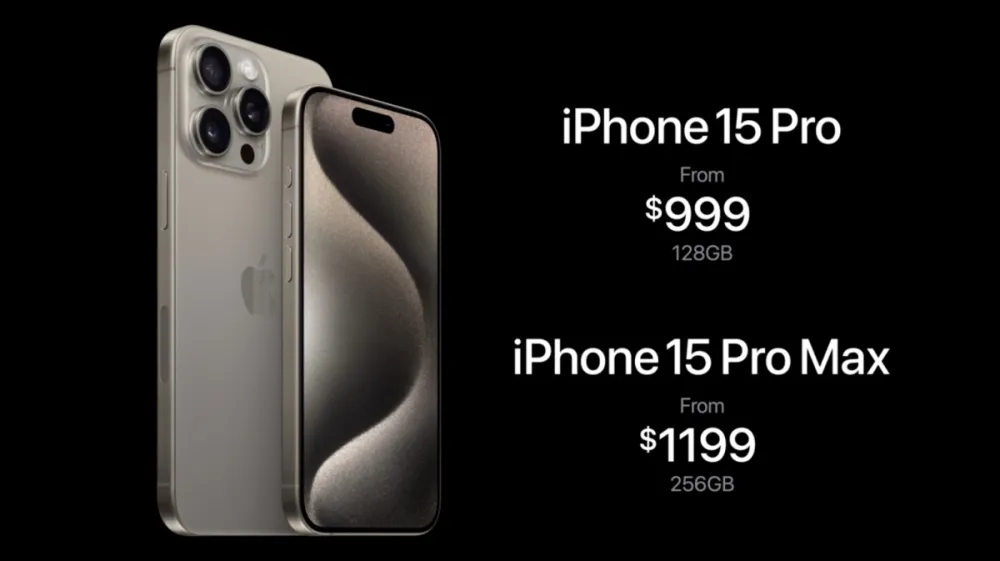iPhone 15 Pro and iPhone 15 Pro Max: titanium frames, A17 Pro processor
In the climactic unveiling of the iPhone 15 Pro and iPhone 15 Pro Max, Apple not only introduced a USB-C port akin to the iPhone 15 but also boasted of incorporating USB 3.0 transmission standards. This promises swifter data transfer and charging efficiencies. Furthermore, the devices are sculpted from titanium, significantly reducing the overall weight of the phone.

Apple reveals that the chassis of both the iPhone 15 Pro and iPhone 15 Pro Max are crafted from Grade 5 titanium alloy. These are then anodized for coloration and further enhanced with a Physical Vapor Deposition (PVD) coating to augment surface durability. The color palette comprises black, white, blue, and the natural shade of titanium, notably eliminating the gold variant.
The USB-C, in line with the USB 3.0 specifications, supports a data transfer rate of up to 10Gbps. This permits the iPhone 15 Pro and iPhone 15 Pro Max to transfer data directly through USB-C-connected external storage or to capture video directly when linked to a computer. Notably, its charging speed surpasses that of the USB 2.0-based iPhone 15.
A significant innovation is the replacement of the long-standing mute toggle with a touch-operated ‘Action Button’. By default, it still manages mute toggling but can be customized by users for quick access to the camera, flashlight, or voice memos. The processor is empowered by the cutting-edge A17 Pro, manufactured using TSMC’s 3nm process, which encompasses 190 billion transistors. The CPU is composed of two performance cores and four efficiency cores, while the GPU, also Apple-designed, is said to showcase remarkable real-time ray tracing. High-profile gaming companies like Ubisoft and CAPCOM have hinted at launching AAA-grade games for the iPhone 15 Pro.
Display-wise, the iPhone 15 Pro boasts a 6.1-inch design, while the iPhone 15 Pro Max retains its 6.7-inch display. Both support 120Hz ProMotion and HDR visual effects with a peak brightness reaching 2000 nits. They also feature the second-generation UWB ultra-wideband chip and support Wi-Fi 6E wireless connectivity.
In the realm of photography, both models feature a primary camera of 48 megapixels. The telephoto lens supports 3x optical zoom, which when paired with a quad-prism design, can achieve up to 5x optical zoom equivalent to 120mm, ensuring exquisite distant photography. The ultra-wide lens also facilitates macro photography. Together with the primary and telephoto lenses, the devices cater to various focal lengths, satisfying diverse creative requirements.
Additionally, the iPhone 15 Pro and iPhone 15 Pro Max are adept at capturing spatial videos, which can be viewed through the Vision Pro virtual reality headset. This feature’s launch is anticipated later this year, though it remains uncertain if it will be exclusive to the iPhone 15 Pro and its superior models.
In terms of pricing, the iPhone 15 Pro starts at $999, with storage options beginning from 128GB, and extending up to 1TB. The iPhone 15 Pro Max is priced at $1,199, offering storage from 256GB, also up to 1TB.

Both phones will be available for pre-order from 8 p.m. on September 15, with an official release on September 22. Coinciding with this launch, Apple also introduces 6TB and 12TB storage options for iCloud+, catering to users’ growing photo backup needs.
Post the release of the iPhone 15 series, Apple positions the iPhone SE as the entry-level option, with the iPhone 13 serving as an advanced choice. The iPhone 14 and iPhone 14 Plus are pitched as premium selections, distinctively priced from the new iPhone 15 series.
Simultaneously, Apple confirms the discontinuation of the previously launched iPhone mini variants.






